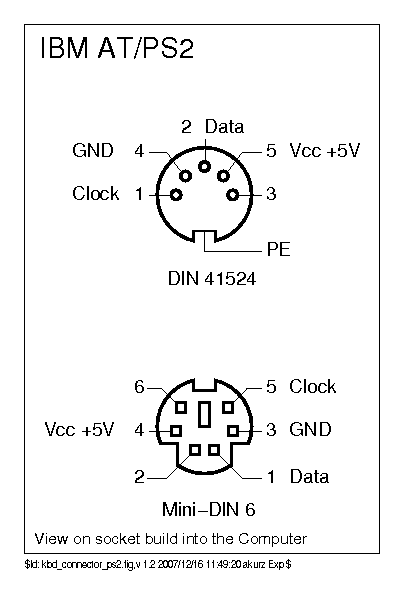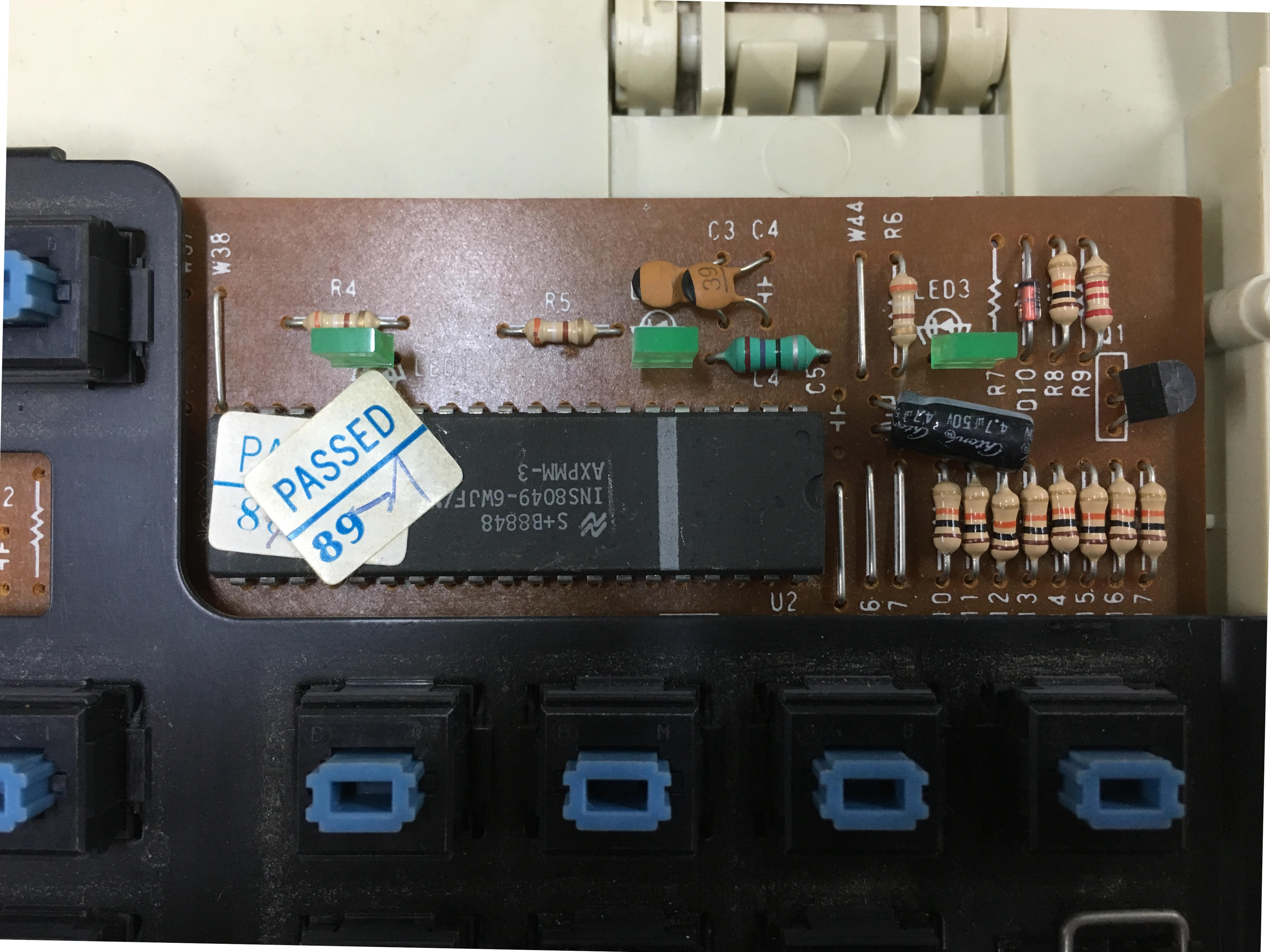Trying to convert a DIN5 keyboard to USB
- Archersby
- Main keyboard: Logitech G910
- Main mouse: Mad Catz RAT 4 or EVGA X20
I've been trying to get my Monterey (or Mtek) K-104 to work on my Win 11 PC by connecting it to a Rohs DIN5 to PS/2 converter and then connecting that to a Monoprice PS/2 to USB converter. The lock keys work, but I can't type anything.
The funny thing is that this setup used to work on an Optiplex that I had a year or so ago!
Since I don't have a computer with a DIN5 connector, I can't see whether or not the keyboard (or any of the connectors) are dead. The K-10 has a switch with labels A, X, and S, so I don't know if that has anything to do with it. I've tried cleaning it, plugging it in while my PC's off, and unplugging my main keyboard...
Might anyone here have any ideas about what to do?
The funny thing is that this setup used to work on an Optiplex that I had a year or so ago!
Since I don't have a computer with a DIN5 connector, I can't see whether or not the keyboard (or any of the connectors) are dead. The K-10 has a switch with labels A, X, and S, so I don't know if that has anything to do with it. I've tried cleaning it, plugging it in while my PC's off, and unplugging my main keyboard...
Might anyone here have any ideas about what to do?
- Polecat
- Location: Downstream from Silicon Valley
- Main keyboard: Monterey K104 Industrial Gray
- Main mouse: Logitech Optical
- Favorite switch: Early Alps SKCM
- DT Pro Member: -
The K104 is AT-compatible, which means a passive DIN5 to PS/2 adapter will get it to PS/2. It does not have native USB, which means your PS/2 to USB converter needs to be an active one, not just a pin adapter. I use a K104 as my driver, typing on it now in fact. I've used blue cube and Radio Shack dongle adapters with it, but mostly I use a Soarers that I bought from Orihalcon on ebay.
The A-X-S switch selects the mode. For most converters you'll need to use the A (AT) position. X is XT, which Soarers also supports. S is XT but with the CapsLock working like a typewriter, where it releases when you hit the left shift.
The A-X-S switch selects the mode. For most converters you'll need to use the A (AT) position. X is XT, which Soarers also supports. S is XT but with the CapsLock working like a typewriter, where it releases when you hit the left shift.
- Muirium
- µ
- Location: Edinburgh, Scotland
- Main keyboard: HHKB Type-S with Bluetooth by Hasu
- Main mouse: Apple Magic Mouse
- Favorite switch: Gotta Try 'Em All
- DT Pro Member: µ
A Soarer converter is always a good idea.
But double check you have that switch in the A position, before you go buying anything, as it seems the most likely culprit this thing stopped working after it did before.
But double check you have that switch in the A position, before you go buying anything, as it seems the most likely culprit this thing stopped working after it did before.
- Archersby
- Main keyboard: Logitech G910
- Main mouse: Mad Catz RAT 4 or EVGA X20
I've tried connecting the DIN-PS/2 connector to a PC with a PS/2 port and it didn't work. The PS/2-USB connector is definitely active, so I guess I just need a different DIN connector. Hopefully, my keyboard isn't just dead.
(By the way, the caps lock keys only turn on while in XT mode. Might that mean anything?)
(By the way, the caps lock keys only turn on while in XT mode. Might that mean anything?)
- Muirium
- µ
- Location: Edinburgh, Scotland
- Main keyboard: HHKB Type-S with Bluetooth by Hasu
- Main mouse: Apple Magic Mouse
- Favorite switch: Gotta Try 'Em All
- DT Pro Member: µ
Din to ps/2 is as simple as it gets: there are no electronics in those adapters. Very very unlikely said adapter is broken, if it’s the solid plastic kind. If it’s a little cable with sockets on both ends though, then there’s a chance it’s to blame.
More likely the keyboard itself, I think. Usual suspect: leaking capacitors.
The Caps Lock LED on XT is a simple hack manufacturers had to do. XT is so dumb it’s unidirectional: no way for the host computer to control the lock lights on the keyboard. IBM did not design XT for keyboards with lock lights anyway, but cloners did hacks like this to kinda sorta work with it. Great fun for the user when the toggled status wasn’t in sync, I bet.
You absolutely sure the keyboard isn’t working with a ps/2 port in ***AT*** mode?
More likely the keyboard itself, I think. Usual suspect: leaking capacitors.
The Caps Lock LED on XT is a simple hack manufacturers had to do. XT is so dumb it’s unidirectional: no way for the host computer to control the lock lights on the keyboard. IBM did not design XT for keyboards with lock lights anyway, but cloners did hacks like this to kinda sorta work with it. Great fun for the user when the toggled status wasn’t in sync, I bet.
You absolutely sure the keyboard isn’t working with a ps/2 port in ***AT*** mode?
- Muirium
- µ
- Location: Edinburgh, Scotland
- Main keyboard: HHKB Type-S with Bluetooth by Hasu
- Main mouse: Apple Magic Mouse
- Favorite switch: Gotta Try 'Em All
- DT Pro Member: µ
You can test that cable with a multimeter. The corresponding pins are simply connected to each other:

Only Ground, Vcc, Clock and Data matter. The outside rim of each should also be connected, as earth.

Only Ground, Vcc, Clock and Data matter. The outside rim of each should also be connected, as earth.
- Polecat
- Location: Downstream from Silicon Valley
- Main keyboard: Monterey K104 Industrial Gray
- Main mouse: Logitech Optical
- Favorite switch: Early Alps SKCM
- DT Pro Member: -
To expand on Mu's reply, the CapsLock state works differently in XT and AT modes. In XT mode the LED signal is generated internally, but in AT mode the CapsLock state is set through the cable from the computer so the two can stay in sync. So it sounds like the keyboard is getting power, but not seeing the clock or data signal from the computer. That could be the adapter, or it could be the keyboard cable or the keyboard itself.Archersby wrote: 08 Jan 2023, 15:32 I've tried connecting the DIN-PS/2 connector to a PC with a PS/2 port and it didn't work. The PS/2-USB connector is definitely active, so I guess I just need a different DIN connector. Hopefully, my keyboard isn't just dead.
(By the way, the caps lock keys only turn on while in XT mode. Might that mean anything?)
You might try working the A-X-S switch back and forth several times in case the contacts are dirty or corroded. And be aware that in AT or PS/2 mode that switch needs to be set before the computer boots so the computer can identify the keyboard correctly. USB converters usually identify correctly when hot plugged, but the keyboard needs to be plugged into the converter first, for the same reason.
- Archersby
- Main keyboard: Logitech G910
- Main mouse: Mad Catz RAT 4 or EVGA X20
Thanks for the help mates, but I think that age must've gotten to it 
Tried a cable-less Din to PS/2 connector and it still won't work. I've exclusively done what Polecat said (Plugging it into a powered off PC) when I use it, but the computer still won't detect it. "Detect" because my PS/2 PC won't boot to OS without detecting a keyboard.
Don't know if there's anything else I can do (besides a repair) since I'm pretty much a noob to vintage keyboarding...
Tried a cable-less Din to PS/2 connector and it still won't work. I've exclusively done what Polecat said (Plugging it into a powered off PC) when I use it, but the computer still won't detect it. "Detect" because my PS/2 PC won't boot to OS without detecting a keyboard.
Don't know if there's anything else I can do (besides a repair) since I'm pretty much a noob to vintage keyboarding...
- Muirium
- µ
- Location: Edinburgh, Scotland
- Main keyboard: HHKB Type-S with Bluetooth by Hasu
- Main mouse: Apple Magic Mouse
- Favorite switch: Gotta Try 'Em All
- DT Pro Member: µ
The keyboard's controller does seem the likely culprit. I'd try testing it on one more AT / PS2 host computer before being sure about it, but you're very likely right.
Going by the wiki, does your PCB look like this? Have I got the right keyboard?

That controller runs on the (ubiquitous) Intel MCS-48 chip. (You won't always see an Intel logo, as other manufacturers second sourced it.) They were an affordable microcontroller back in the day: programmed during manufacture but unalterable for us mere users. They have the same / similar* footprint to truly programmable controllers like the Teensy++. They are indeed removable with determination. If you put something else in there, you can do advanced stuff like QMK or even Bluetooth.
But before getting deep and hacky, see that electrolytic capacitor nestled between the resistors? Is yours leaking, perchance? Try measuring its capacitance. If it's out of spec, the controller may not be to blame and might just jump back to life once the cap's replaced. I'd start with that.
*I’m waiting on a delayed homebound flight at JFK after very little sleep. Excuse increased µisms.
Going by the wiki, does your PCB look like this? Have I got the right keyboard?

That controller runs on the (ubiquitous) Intel MCS-48 chip. (You won't always see an Intel logo, as other manufacturers second sourced it.) They were an affordable microcontroller back in the day: programmed during manufacture but unalterable for us mere users. They have the same / similar* footprint to truly programmable controllers like the Teensy++. They are indeed removable with determination. If you put something else in there, you can do advanced stuff like QMK or even Bluetooth.
But before getting deep and hacky, see that electrolytic capacitor nestled between the resistors? Is yours leaking, perchance? Try measuring its capacitance. If it's out of spec, the controller may not be to blame and might just jump back to life once the cap's replaced. I'd start with that.
*I’m waiting on a delayed homebound flight at JFK after very little sleep. Excuse increased µisms.